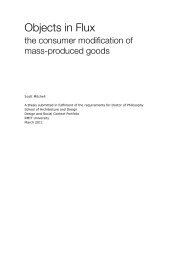Making Memory Space: Recollection and Reconciliation in Post ...
Making Memory Space: Recollection and Reconciliation in Post ...
Making Memory Space: Recollection and Reconciliation in Post ...
You also want an ePaper? Increase the reach of your titles
YUMPU automatically turns print PDFs into web optimized ePapers that Google loves.
uild<strong>in</strong>g type that has traditionally been recognised as the only architecture of worth <strong>in</strong> South Africa. 74<br />
Farms <strong>and</strong> homesteads constructed <strong>in</strong> this manner still form iconic representations of the Cape area<br />
<strong>and</strong> highlight a historical claim to the l<strong>and</strong> of southern Africa. The Cape Dutch style signifies the Dutch<br />
rule of the Cape, which lasted from Jan Van Riebeck’s arrival <strong>in</strong> 1652 until around 1795. Under<br />
Apartheid it was considered the most ‘authentic’ form of architectural heritage, an attitude which<br />
complicates the cont<strong>in</strong>ued emphasis placed on Cape Dutch architecture as a valued representative of<br />
South African past. Cape Dutch architecture represents a time of subjugation for black South Africans,<br />
while simultaneously embody<strong>in</strong>g values of heritage, culture <strong>and</strong> ref<strong>in</strong>ement for Afrikaner South<br />
Africans. 75 In fact many of the orig<strong>in</strong>al Cape Dutch homesteads along the w<strong>in</strong>e region of the Southern<br />
Cape are based on a silent history of slavery, a historical narrative largely absent from their popular<br />
identity. 76 In <strong>in</strong>ternational terms, the white gabled forms of the Cape are widely recognised as iconic<br />
South African forms, an identity often synonymous with touristic notions of South Africa.<br />
Colonisation<br />
The impact of the British occupation <strong>and</strong> colonisation has also left a shadow on the urbanscape of<br />
South Africa. It follows a pattern of spatial production not unlike that experienced <strong>in</strong> other colonial<br />
outposts around the world: the imposition of the cartographic grid on the cityscape, the construction of<br />
parks, botanical gardens <strong>and</strong> build<strong>in</strong>gs <strong>and</strong> the erection of monuments <strong>and</strong> memorials to significant<br />
figures such as Queen Victoria. Architectural form was gr<strong>and</strong> <strong>and</strong> impos<strong>in</strong>g, allud<strong>in</strong>g to a classical<br />
tradition of antiquity <strong>and</strong> mastery of the natural environment. In many respects this mode of production<br />
forms the basis for the emergence of the rudimentary city as it exists <strong>in</strong> South Africa, particularly <strong>in</strong> the<br />
Cape, <strong>and</strong> many of the significant icons of the city are resultant from the attitudes to spatial production<br />
at this time. 77<br />
Heritage <strong>and</strong> nationalistic form<br />
This method of build<strong>in</strong>g practice began to change after the Union of South Africa (established <strong>in</strong><br />
1910), saw the development of newly-forged productions of nationalistic architectural narratives. At<br />
this time, there was an emergence of <strong>in</strong>terest <strong>in</strong> notions of ‘heritage’ under the particular guidance of<br />
Jan Smuts. This preoccupation was crystallised <strong>in</strong> the form of the ‘Declaration of Monuments’ by the<br />
newly established Commission for the Preservation of Natural <strong>and</strong> Historic Monuments, Relics <strong>and</strong><br />
Antiques. 78 This legislation employed selective heritage practice <strong>in</strong> the realm of nation build<strong>in</strong>g <strong>and</strong><br />
74 Noeleen Murray <strong>and</strong> Nick Shepherd, ‘<strong>Space</strong>, <strong>Memory</strong> <strong>and</strong> Identity <strong>in</strong> the <strong>Post</strong>-Apartheid City,’ Noeleen Murray, Nick<br />
Shepherd, <strong>and</strong> Mart<strong>in</strong> Hall (eds.), Desire L<strong>in</strong>es: <strong>Space</strong>, <strong>Memory</strong> <strong>and</strong> Identity <strong>in</strong> the <strong>Post</strong> Apartheid City (Oxon: Routledge, 2007),<br />
p.3.<br />
75 For an exam<strong>in</strong>ation of heritage, experience <strong>and</strong> Cape Dutch Architecture refer to Mart<strong>in</strong> Hall <strong>and</strong> Pia Bombarella, ‘Paths of<br />
Nostalgia <strong>and</strong> Desire through Heritage dest<strong>in</strong>ations at the Cape of Good Hope’, Noeleen Murray, Nick Shepherd, <strong>and</strong> Mart<strong>in</strong><br />
Hall (eds.) Op cit.<br />
76 Kerry Ward <strong>and</strong> Nigel Worden, Op cit, p.203.<br />
77 Noeleen Murray <strong>and</strong> Nick Shepherd, Op cit, p.4.<br />
78 Ibid.<br />
30
















